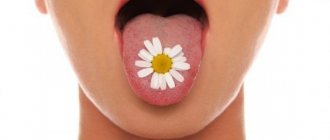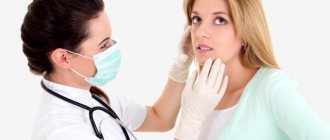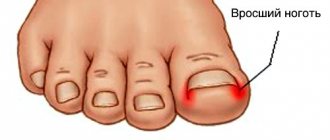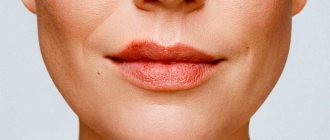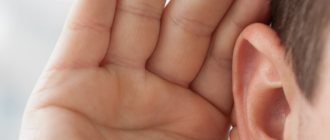— Natalia Vyacheslavovna, what is the name of the disease in dermatology, which is simply called “jam”?
— Zaeda is the popular name for a skin condition. And in medical terminology this is angular cheilitis. It is localized precisely in the corners of the lips. And the lips are such an interesting organ that has a specific structure that distinguishes it from both the skin and the mucous membrane. That is, this is such a borderline state - not yet a mouth, but no longer a face, figuratively speaking. So, cheilitis develops precisely on the red border of the lips - this is the part of the muscles and skin of the face that we see. We call them lips, but in general they are nothing more than a red border, if you remember the anatomy.
- What causes cheilitis?
- There can be many reasons - from the most banal to serious precancerous conditions. Only a doctor can assess the situation during an examination and when collecting complaints.
— Are there any tests that can confirm this disease?
— Today there are non-invasive research methods, such as dermatoscopy. A study on pathological microflora is also prescribed - using scraping, when skin flakes from the affected area are taken for analysis.
— If we talk about the simple version of cheilitis, what most often causes it?
— Lips are a rather delicate area, which is located in an open area. It is subject to constant aggressive environmental influences and temperature changes. Cosmetics are applied to the lips - glosses, lipsticks, which often contain harmful chemical components. Smoking provokes the disease, both regular cigarettes and newfangled gadgets - electronic cigarettes, vapes. And, mind you, they are smoked most often by very young people. They significantly damage the red border of the lips.
— That is, there is practically no natural protection for the lips?
- Unfortunately it is so. Therefore, anything that injures the red border is potentially dangerous in terms of the development of cheilitis and the most serious diseases. There is not even a lipid film on the lips, which is present on other areas of the skin. Therefore, lips instantly become chapped in the cold, in the wind, or in the open sun.
— And it turns out that your lips don’t have their own mechanism for moisturizing?
— On the red border there are practically no sweat and sebaceous glands that would soften or moisturize this part of the face. There are only special glands, they are located in the corners of the lips. Accordingly, lips are not moisturized. This causes dryness and cracks. There is even such a diagnosis as “meteorological angular cheilitis”. It is placed when there is a clear dependence on the environment, for example, on weathering. And the treatment here is very simple: protection and hydration.
Staphylococcus, streptococcus in small quantities in a healthy person is normal. But with a decrease in immune factors, microorganisms begin to develop.
— So you need to constantly wear hygienic lipstick?
- Not everything is so simple here. Now there is a question about the use of lipsticks, their composition and effect on the skin are being studied. And more and more often there is an opinion that many of them are harmful to the skin. We are talking about those lipsticks that contain glycerin. The glycerol molecule is capable of attracting water. As a result, moisturizing lipstick has a drying effect. Patients often encounter this: they smear lipstick on their lips, getting the opposite effect. Therefore, you should always carefully study the composition of cosmetics and ensure that they do not contain harmful, aggressive components.
— Bacteria can probably get into the irritated corners of the lips at some point?
- Both bacteria and fungi... If we are talking about a bacterial environment, then this is often paired with caries, stomatitis, and then we already see a disease where the infection comes to the fore. And this is no longer cheilitis, but impetigo. But among the people it’s still a jam.
—That is, a person “disperses” his own bacteria to different parts of the body, including the corners of his lips?
— More often than not, infection occurs due to failure to comply with basic hygiene rules, when they use less than clean cutlery and dishes.
— Can acidic environments corrode the skin of the lips? The same pineapple?
— If we are talking about any acidic environment, then yes, it can cause destruction of the surface layer of the skin. But pineapple is a different story. This is a fruit that contains certain substances - enzymes. They can even corrode protein tissue, including the skin of the lips. Nutritionists even have this joke: it is not known who eats whom: we - pineapple or pineapple - us! When you eat a quality pineapple, your tongue tingles. Therefore, the joke has some medical basis. Enzymes can actually break down the protein structure of a molecule. But this reaction is not aggressive, therefore, in principle, not dangerous. And an important note: even in an aggressive environment, not everyone develops cheilitis. Certain conditions are required on the part of the body itself.
- What conditions?
— Most often these are concomitant diseases. Diabetes mellitus, diseases of the thyroid gland, gastrointestinal tract, which lead to changes in the pH of the skin, which in turn makes the development of bacteria comfortable in a certain acid-base environment. That is, when the body, for one reason or another, leaves a state of stability, additional problems begin. Including skin ones.
Natalia Zhovtan, dermatologist:
“There is actinic cheilitis, which is caused by constant exposure to ultraviolet radiation. Men who spend long periods of time in the sun are more susceptible to it. Over time, cracks in the corners of the lips turn into ulcers that do not heal for a long time. As a result, they can develop into a malignant disease. Trauma and constant ultraviolet irradiation can lead to skin cancer. That’s why sun protection is more important now than ever.”
— It turns out that binge eating tells us that there are problems with the immune system?
- This can be a reaction to a weakened immune system, an independent disease, or a secondary manifestation of another disease. This is very important to understand, because it determines how to treat.
— An experienced doctor will immediately determine what this option is?
— In principle, diagnosis is not difficult. If there are erosions, cracks - all this is angular cheilitis. And then we’ll look into the details. If, for example, the problem is caused by atopic dermatitis, a concomitant disease in an adult or child, then there is no need for antibiotics or antifungal drugs. Most likely, antiallergic drugs will be needed here.
- And if it is still a fungal disease, where can a person get it? For example, can you get infected in the cafeteria? And most importantly, is it transmitted from person to person?
- Most often, this kind of seizure is caused by candidal fungus - candida. It spreads easily and quickly because the area around the corners of the lips has ideal conditions for it. It is always humid there, obese people have folds of skin... You can become infected from a sick person through direct contact, as well as by using poorly washed dishes in public catering. But you don’t need to paint a picture that mushrooms live in cafes and restaurants! (Laughs.) Each person’s skin has its own microbiome. This is a community of beneficial or harmful microorganisms, including fungi. And under certain conditions - and most often these are diabetes mellitus, hormonal, endocrine disorders, immunodeficiency, HIV, and other diseases that require immune suppression - pathogenic microorganisms begin their vigorous activity, since the immune system is no longer able to restrain them.
— So, your own mushrooms grow?
- Exactly, and it looks like erosion, a whitish coating on the skin in the corner of the mouth - that is, the picture is specific, so the doctor can easily diagnose “candidal cheilitis” and prescribe treatment. This version of the jam does not bother to masquerade as something else.
— If the disease is bacteriological in nature, is it somehow different from this option? They say that streptococcus is very difficult to treat.
“Everything can actually be treated.” Staphylococcus, streptococcus - these microorganisms are present in small quantities in a healthy person. And this is the norm. But under certain conditions, when immune factors decrease, microorganisms begin to develop. The result is either streptoderma or impetigo. Skin diseases, which are also called seizures, but the nature of their occurrence is bacteriological. They develop in conditions of injury and reduced immunity.
— From everything you said, the conclusion is clear: you can’t diagnose yourself...
- Self-medication is impossible here. Patients suffer for months, prescribing themselves vitamins, healing or even hormonal ointments... But until the true cause of the disease is determined, there will be no treatment results. It is even more dangerous and irresponsible to “prescribe” yourself antibiotics. Medicine is faced with the problem of resistance to existing antibiotics. This is the scourge of healthcare. Therefore, before prescribing an antibacterial ointment, cultures are taken from the corners of the mouth to find out what microorganisms “live” there and to which antibiotic they are most sensitive. Only after this the doctor has the right to prescribe treatment.
Not all hygienic lipsticks are equally beneficial for the lips; sometimes they can cause inflammation in the corners.
— What is included in the prevention of cheilitis?
- In the first place - moisturizers. But without glycerin, as I already said. Sunscreen is required. There are lipsticks that contain UV filters. And a trivial, but very important piece of advice: at the first manifestations of the disease, consult a doctor as soon as possible. Do not self-medicate, do not blur the picture. The sooner you contact, the more clear the doctor will be about what is happening to you.
— How much time can you give for such a treatment option as “it will go away on its own”?
- No more than a week. Ten days at most. If regeneration and complete recovery do not occur during this time, see a doctor!
— They say that dermatologists are very critical of toothpicks: people have the habit of getting them wet in the corner of their mouth, and then they develop a problem such as sticking.
— Toothpicks are harmful for two reasons. When a wooden stick rubs against the skin, the integrity of its cover is damaged. And wood retains bacteria well. And plus a favorable environment around the mouth - moist and warm. There are simply excellent conditions here for the rapid propagation of infection!
— Can a toothbrush be a traumatic element?
— Toothbrushes have smooth edges and fairly soft surfaces, so they should not injure the red border of the lips. Unless, of course, you open your mouth too wide when brushing your teeth. There are also certain hygienic requirements for a toothbrush; they are usually voiced by dentists. Basically, they are familiar to everyone: the brush should be changed regularly, it should be individual, and so on.
- Larisa Zelinskaya
- Amurskaya Pravda from 06/20/2019
Diagnostics
When visiting a doctor with a problem such as seizures, a visual examination is first performed. To determine the type of angulitis, additional laboratory tests may be prescribed. This is necessary to prescribe the correct, most effective treatment. Various urine and blood tests and liver tests are required. The presence of various infectious diseases is determined, in some cases an ultrasound examination of the abdominal cavity is performed. In severe cases of angulitis, which is a consequence of a more serious systemic disease, consultation with a specialist is required.
Recommendations ↑
For angulitis treatment to be successful, you need to follow a number of recommendations regarding your daily lifestyle.
Thus, patients must follow a certain diet, which consists of avoiding spicy, salty and sour foods and dishes in the diet, reducing the amount of fried food, eating steamed or baked meat and fish. If this disease is caused by fungi, then all sweets are excluded.
It is worth increasing the share of foods rich in B vitamins and iron, such as:
- liver,
- almond,
- peanut,
- apples,
- grenades,
- cabbage of all varieties,
- any dairy products.
Treatment and prevention of relapse also includes complete cessation of smoking.
People prone to frequent occurrence of angulitis should wean themselves from the habit of licking their lips.
And to ensure that the skin is always moisturized and softened, it is recommended to use medicinal cosmetics - hygienic lipsticks, lip balms with vitamins, etc.
Symptoms of angular cheilitis
The main symptom of seizures is the presence of inflammatory changes in the corners of the lips:
- redness;
- wounds;
- crusts or plaque;
- cracks.
Zaeda causes pain when opening the mouth, accompanied by itching, burning and a feeling of tightness, especially when eating food. Candida and streptococcal infections differ in their external manifestation.
Candidiasis and streptococcal infections: how to distinguish them?
Streptococcal infection
, most often manifests itself in children. Inflammation manifests itself in the corners of the mouth as flakislothens (bubbles) with a flaccid thin lining. In place of the bubble, a slit-shaped erosion quickly forms, covered with a purulent-bloody crust. After its removal, a red, wet, slightly bleeding surface with a crack in the center is exposed. After a few hours, the jam becomes crusty again. The process may be painful when opening the mouth.
With candidiasis, there may be other manifestations of candidiasis. Zaedu should not be confused with erosive papules in syphilis, which can be distinguished by the presence of compaction at the base of the erosion, pale treponemas in the discharge, as well as with other signs of syphilis, for example, positive serological reactions to syphilis.
Types of angular cheilitis:
Seizures are divided into types depending on their pathogen, which is the cause of the inflammatory process. Types of jam:
- Candidal infection (candidiasis angulitis)
is a fungal infection of the skin in the corners of the lips. - Streptococcal impetigo (slit-shaped streptococcal impetigo)
is caused by the bacterium streptococcus, which is a type of streptoderma.
Seizure of mixed etiology - inflammation can be caused by both bacteria and fungi. This usually occurs with chronic eating associated with reduced immunity.
In addition, seizures may differ in their course:
- Acute seizures
- the onset is acute, respond well to treatment and end with complete recovery and restoration of the skin in the corners of the lips. Most often they appear as a separate skin defect, and not as symptoms of other diseases and conditions of the body. - Chronic seizures
have a slow, long-term course, are often repeated, and can persist for months. Chronic seizures form deeper cracks, and the rashes spread beyond the corners of the mouth to the skin of the face, lips or mucous membranes of the oral cavity. Chronic seizures are a manifestation of reduced immunity, and less often occur under the influence of a constant irritating factor (for example, with an incorrect bite, smoking, the habit of biting nails).
Also, seizures can be unilateral or bilateral. In childhood, streptococcal seizures are more common, rarely turning into a chronic condition. Fungal angulitis is most often a manifestation of reduced immunity and is chronic. With a fungal infection, other candidal manifestations can often be identified (glossitis, candidal stomatitis, etc.).
Causes of seizure
The disease does not always develop along a complex course. However, the picture of the disease is almost the same - it is an intensification of infection and a decrease in immunity in chronic foci, for example, the oral cavity, tonsils, paranasal sinuses, and the upper respiratory tract. Plus, the effect of local factors, such as microtrauma of the lips and deficiency of vitamins and minerals, which leads to angulitis.
Angulite is mainly activated during the off-season , most often in the spring. At this time, the load on the body, especially on the immune system, increases. The body decreases the content of vitamins and microelements that are necessary to maintain the immune system. After a cold winter, we try to bask more in the sun's rays; it is important not to overdo it in this process, because many children have increased photosensitivity. Also, an allergic reaction in women to cosmetics stimulates the initial stage of angulitis, as does dry lips, which is caused by the habit of constantly licking the lips.
Seizures can occur at any age, both in children and adults. Also, the disease can appear at any time of the year, but most often it occurs in the spring.
Seizures are an infection caused by bacteria that can be spread through dishes and kisses, as well as common objects, caused by staphylococcus or fungus.
Thus, the development of streptococcal infections contributes to:
- Cracks, including microtraumas caused by dry skin.
- Dirty skin.
- Overheating or hypothermia.
- Habit of biting or licking lips.
- Caries.
- Poorly fitted dentures or braces.
- Poor oral care.
There are a number of other reasons that provoke the appearance of jamming, ranging from an allergy to certain foods or toothpaste, and even reaching a malocclusion.
Most often, seizures appear due to a lack of riboflavin - vitamin B2 - in the body. In this case, angulitis is accompanied by peeling of the skin on the face, redness and burning of the tongue. Patients complain of loss of appetite, weakness, and rapid loss of strength.
Causes of angular cheilitis
The development of angulitis can be caused by several factors:
- decreased immunity, for example, in the autumn-spring period;
- deficiency of vitamins, especially vitamin B2;
- diabetes;
- HIV infection;
- maceration (soaking) of the skin due to constant licking of the lips or malocclusion;
- taking certain medications (antibiotics, corticosteroids, cytostatics);
- insufficient oral hygiene or using someone else’s toothbrush to brush your teeth;
- habit of biting nails;
- caries;
Types of angulitis and its manifestations
There are two main types of angular stomatitis - candidal and streptococcal (depending on what infection it was caused by) . Their symptoms have characteristic manifestations, which can be used to suggest a disease, conduct laboratory analysis for diagnostic purposes, and, based on the data, prescribe effective treatment.
Candidal angulitis develops as a result of increased proliferation of yeast-like fungi Candida on the skin and oral mucosa. Signs of this type of seizure are varnish-red erosion with a slit-like shape. Often the affected area is covered with a grayish coating, which is easily removed. With candidal angulitis, a crust does not form. This kind of food is constantly moisturized. In the absence of timely treatment, the disease becomes chronic and manifests itself in the form of periodic relapses.
Streptococcal angulitis can be visually distinguished from candidal angulitis in that it looks like a vesicle that quickly disappears . In its place a painful crack appears, surrounded by a purulent-bloody crust. Even if the mouth is closed, the manifestation of the disease will be clearly visible.
If you suddenly tear off the crust, then in its place a bare bleeding wound will appear. Literally in an hour or two it will crust over again. There are very unpleasant sensations. The affected area of skin and mucous membranes may burn and itch. When eating salty, sour or spicy foods, the pain increases. Streptococcal angulitis is most common among children.
It is important to distinguish streptococcal angulitis from seizures of syphilitic origin. In their manifestations they are similar, but in the method of treatment they are completely different. To do this, you should undergo testing for a number of serological reactions.
How does angulitis develop?
Angular cheilitis is a disease of the mucous membrane of the oral cavity and the skin of the lips, manifested in the form of an area of redness, which indicates inflammation.
Over time, the jam becomes covered with a dry crust, and a crack often appears. Often the crust is accidentally torn off, which is why everything repeats again. This provokes extremely unpleasant sensations that prevent you from doing your usual activities as normal. When eating, it is difficult to eat, talk, laugh, and for women who use decorative cosmetics for their lips, angulitis causes special suffering. In addition, this phenomenon is often an aesthetic problem.
Angulitis develops when opportunistic flora, living on the mucous membrane and skin of the mouth even in a healthy person, suddenly begins to actively multiply under the influence of various factors.
Very often, the disease cheilitis develops in the spring, when the body is exhausted after winter and lacks vitamins, minerals and other essential substances. Because of this, pathogenic microorganisms receive a “green” light and their number begins to increase rapidly. Cheilitis can be caused by fungi of the genus Candida or streptococci. In some cases, the infection is of a mixed type.
Sometimes angulitis is confused with herpes. Indeed, their manifestations are largely similar, but there are also some differences. In addition, the treatment for the two diseases will be different.
Recommendations for patients
To treat the disease, it is necessary to first eliminate external irritants that have a negative effect on the skin.
Patients suffering from angulitis need to:
- Quit smoking.
- Review your diet by removing sour and spicy foods from the menu. It is necessary to include foods containing iron and B vitamins in your food, such as liver, apples, pomegranates, dairy products, peanuts, cabbage, and almonds.
- Avoid licking your lips frequently.
- To soften the skin around the mouth during seizures, it is necessary to use cosmetics with a medicinal bias - hygienic lipstick or lip balm with components and vitamins that soften your skin.
Read also: Types of teeth cleaning
Prevention and prognosis
Prevention of angulitis is based on the necessary measures:
- To prevent the development and formation of jams, it is necessary to maintain oral hygiene and regularly visit the dentist for prevention and treatment.
- It is necessary to fortify your diet so as not to repeat the formation of angulitis. In the winter and spring seasons, it is necessary to take vitamin preparations comprehensively.
- Before going outside, do not be lazy to soften the skin of your face and lips with Vaseline or hygienic lipstick to prevent the formation of jams.
It is necessary to treat angulitis without delay, so that the disease does not become chronic. To spur you to action, there are many photos of a mouth with a disease on the Internet. We wish you good health.
